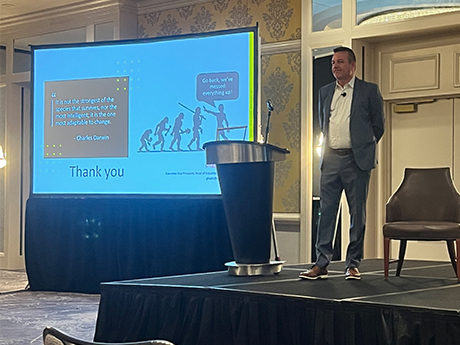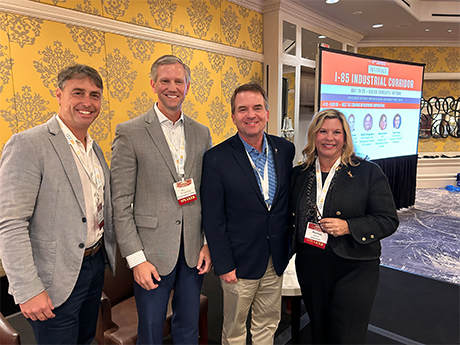CHARLOTTE, N.C. — Tariffs are at the forefront of the U.S. economic landscape as they impact costs and timelines for a multitude of industries. For the industrial real estate sector, developers and tenants alike are monitoring the severity at which tariffs can complicate their everyday business activity, thus economic development officials are playing a crucial role in helping companies mitigate those costs and delays.
“A lot of our business comes down to reducing risks for companies,” said Melissa Smith, senior vice president of the Economic Development Partnership of North Carolina. “There’s a lot of scrambling due to tariffs. They make already challenging deals even more challenging. We have to be ready to help [companies] navigate through these challenges so that they can make a successful decision.”
Editor’s note: InterFace Conference Group, a division of France Media Inc., produces networking and educational conferences for commercial real estate executives. To sign up for email announcements about specific events, visit www.interfaceconferencegroup.com/subscribe.
Smith’s comments came on the opening night of InterFace I-85 Industrial Corridor, a two-day networking and information event held at the Hilton Charlotte Uptown hotel on May 19-20. Brian Young, senior director of Cushman & Wakefield’s Greenville office, moderated the discussion called “Meet the Economic Development Corporations.”
One tool economic developers use to help manufacturers wary of tariffs are foreign trade zones (FTZs), which are duty-free areas outside the jurisdiction of U.S. Customs and Border Protection agency. FTZs are areas, such as manufacturing plants, distribution centers or seaports, where companies can have their customs duties reduced or eliminated in an effort to promote international trade.
Shelby Stringfellow, senior vice president of economic development at the Montgomery Chamber of Commerce in Alabama, spoke about how more manufacturers are inquiring and applying for FTZ status to reduce their tariff exposure.
“What an FTZ allows us to do is essentially address the tariff issue; it’s a short-term solution,” said Stringfellow. “As import goods come into your facility, duties and tariffs are delayed until such time as you sell the product, or the product leaves your inventory.”
Stringfellow said that Hyundai Motor Co., which recently celebrated its 20th year of operation in Alabama, has been operating at a facility in its own designated FTZ “subzone” to lower the car giant’s tariff rate. Hyundai brings in materials that are subject to their own tariff rates, and by re-assembling and packaging those materials and parts into finished products (i.e. vehicles), they are subject to a reduced tariff rate.
“It’s interesting how beneficial the FTZ is,” said Stringfellow.
Stringfellow added that his organization has tracked a 200 percent increase in requests for FTZ status.
John Lummus, president and CEO of the Upstate SC Alliance, said that car manufacturers in his territory, like BMW, are especially vulnerable to tariff increases. On June 4, the United States began imposing a 50 percent tariff rate on steel and aluminum imports, two components that are very prevalent in the production of modern cars. (Foreign automobiles and auto parts also have a 25 percent tariff in place.)
“When bringing in steel and aluminum, the increased cost for cars made in America ranges from $4,000 or $5,000 for each vehicle on the low end to $8,000 or $9,000,” said Lummus. “Tariffs are always inflationary, and they are always going to cause instability.”
Lummus added that tariffs are creating uncertainty with corporate expansions, which is the life’s work of economic development agencies like the Upstate SC Alliance. He said that among the groups he’s working with, about half want to wait and see what happens with tariffs and the other half want to expedite their investment in the United States.
“It’s been a mixed bag,” said Lummus. “I’m very hopeful that this will settle out over time, and possibly we won’t have near the tariffs that are being talked about right now. Our position is free global trade — we do not want to have tariffs on anything.”
The panelists had somewhat opposing views on tariffs. Toward the end of the discussion, Lummus said that tariffs are detrimental to the national economy as the United States is dependent on global markets for success. Stringfellow said that tariffs can be a positive or negative, pointing out that the upcoming expansion at the Port of Mobile should benefit the entire state of Alabama pending the tariff-related disruptions at the West Coast ports. Reuters reports that U.S. imports from China have plunged 28.5 percent year-over-year in May as tariffs on Chinese imports have been enacted, with the Port of Long Beach down 31.6 percent and the Port of Los Angeles down 29.9 percent.
From the keynote
The keynote presenter at the InterFace I-85 Industrial Corridor conference was Gregg Healy, executive vice president of Savills. Healy, who serves as the head of North American industrial services at Savills, spoke about how the U.S. industrial market is transitioning from a state of euphoria to equilibrium.
“For the past five years, if you’re a landlord it was ‘the best of times,’” said Healy, referring to the famous opening line to the Charles Dickens novel A Tale of Two Cities.
“Landlords could build a building, and people would come and lease it up,” said Healy. “If you’re on the tenant side, it was ‘the worst of times’ where you were seeing rental rates increase 50 percent or oftentimes much more. And then you were looking at the renewals saying, ‘How am I going to afford this?’”

Healy referred to the period of overheated industrial development in 2022 to 2024 as “the weird years.” Just along the I-85 corridor, he noted that 215 million square feet has been delivered since the beginning of 2022.
“It was 10 years’ worth of development in three years,” said Healy. “And you wonder why we’re out of whack here a little bit!”
Healy noted that the current U.S. industrial development pipeline is down nearly 60 percent from 2022. At the same time, rental rates have risen almost exactly that same percentage from pre-pandemic levels.
Healy said that the supply-demand dynamics have reverted from “the weird years” where tenants now have some leverage, and rents are coming back down to earth, especially in the I-85 corridor markets that saw massive volumes of supply added.
With construction getting to a more manageable level, Healy noted that industrial developers should be able to stabilize their developments, albeit at a moseying pace due to the sharp rise in rental rates. Atlanta, Charlotte and Greenville-Spartanburg are all at or above double-digit vacancy rates, which exceeds the U.S. vacancy rate of 7.8 percent in the first quarter. Overall, the I-85 industrial corridor has a 9.1 percent vacancy rate, according to Healy.
Leading the leasing momentum in recent months are third-party logistics firms (3PLs). Healy said that 3PLs are responsible for 38 percent of industrial leasing activity the past four quarters in the United States, according to research from Savills. The No. 2 category is manufacturers, which represent 27 percent of leasing volume.
Healy said that the I-85 states have a strong showing in manufacturing investment in recent years, with notable development underway including Hyundai’s mega-plant near Savannah and Johnson & Johnson’s $2 billion biologics manufacturing facility in Wilson, N.C., among others. North Carolina is ranked No. 3 in Savills’ annual manufacturing report, with 67,000 manufacturing jobs announced between 2021 and July 2024. Georgia came in at No. 4 on the list, and South Carolina ranked No. 9.
China and the United States made a 90-day truce settlement in mid-May that reduced the tariff on Chinese goods from 145 percent down to 30 percent, but a longer-term solution has not yet been reached as of this writing. Healy said that a U.S. manufacturing boom could be coming if the trade wars aren’t settled in the near future.
“When we look at reshoring more manufacturing opportunities in the United States, there’s a light at the end of the tunnel, but it is a tunnel,” said Healy. “We don’t know how long we are going to be in the tunnel. These manufacturing plants are the result of a multi-year decision-making process.”
— John Nelson


